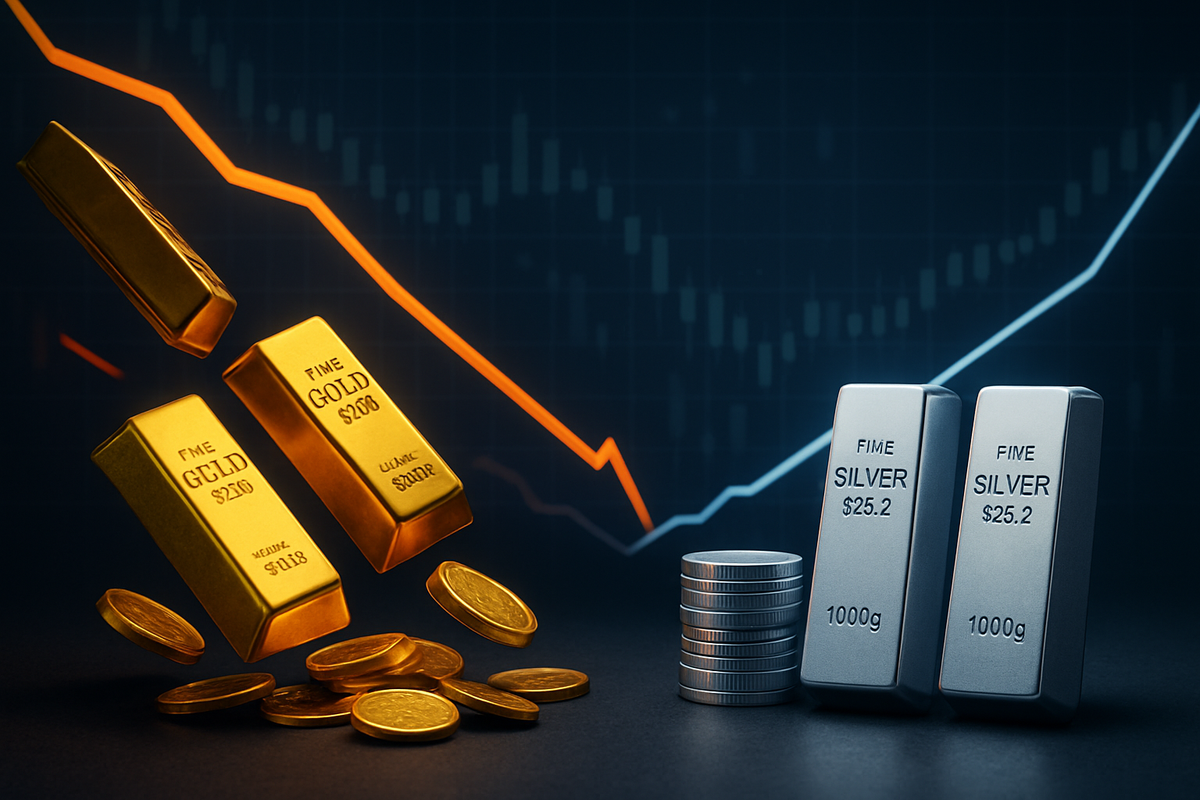
The precious metals market is currently navigating a period of intense volatility, with gold experiencing significant "solid follow-through selling" that has extended its losses in October 2025. This downturn comes on the heels of an impressive rally throughout the year, prompting widespread profit-taking among investors. In stark contrast, silver prices, after enduring a sharp correction, appear to have largely steadied, offering a glimmer of stability amidst the broader market turbulence.
This divergence in immediate price action for gold and silver highlights a complex interplay of market dynamics, including shifting risk sentiment, technical corrections, and the inherent differences in their market structures. As the financial world grapples with the implications of gold's retreat from record highs and silver's newfound equilibrium, MarketMinute will delve into the underlying causes and potential future trajectories for these critical assets.
A Deep Dive into the Precious Metals Rollercoaster
October 2025 has proven to be a watershed month for gold, witnessing a dramatic reversal from its earlier ascent. On October 21st, gold futures experienced their largest single-day percentage decline in over a decade, plummeting by as much as 6.3%. This initial shockwave was followed by further sustained losses, with futures declining more than 6.5% within a 24-hour period after briefly touching fresh record highs. By October 22nd, gold futures continued to track a sharp overnight decline in global prices, as a wave of profit-taking swept through the market. CIMB Investment Bank Bhd (KUL: CIMB) noted that gold recorded its sharpest decline in five years, tumbling 5.3% to US$4,125 per ounce, with spot gold mirroring this trend after a steep 5% plunge—its sharpest single-day drop since August 2020.
Several factors converged to trigger this significant correction. Foremost among them was extensive profit-taking after gold prices surged an astounding 55-57% throughout 2025. Traders, keen to capitalize on these substantial gains, initiated a broad sell-off. Concurrently, an easing of geopolitical tensions, particularly optimism surrounding US-China trade negotiations following positive signals from US President Donald Trump regarding a fair trade deal, reduced the demand for safe-haven assets like gold. Technically, gold's rally had also reached overbought conditions, making a correction overdue, and a rebound in the US Dollar Index further pressured prices, making the metal more expensive for international buyers.
Silver, while not immune to the market's corrective forces, has demonstrated a more resilient trajectory in the latter half of October. On October 21st, silver also experienced a sharp drop, an 8.7% decline that marked its steepest one-day fall since 2021. However, by October 20th, Indian silver prices had held steady at ₹172 per gram after earlier weekly declines, and by October 22nd, silver had largely steadied near $48.55 per ounce, recovering from its earlier steep losses. December silver futures also showed a modest uptick, stabilizing after Tuesday's significant drops. This correction, much like gold's, was primarily driven by profit-taking after silver reached technically overbought conditions, having hit an all-time high of US$54.47 on October 17th. Analysts largely view silver's recent price drop as a healthy market consolidation rather than a fundamental shift in its long-term bullish outlook.
Corporate Fortunes in Flux: Winners and Losers
The recent gyrations in precious metals prices will undoubtedly create both opportunities and challenges for public companies operating within the mining, refining, and investment sectors. For gold mining companies, the extended losses in gold prices could translate into reduced revenues and profit margins, especially for those with higher production costs. Companies like Barrick Gold Corporation (NYSE: GOLD) and Newmont Corporation (NYSE: NEM), as major global gold producers, will be closely watched. A sustained downturn could force them to re-evaluate expansion projects, optimize operational efficiencies, or even divest less profitable assets. Smaller, less capitalized miners might face more severe pressure, potentially leading to project delays or even insolvencies if prices remain depressed for an extended period.
Conversely, companies involved in hedging or those with significant short positions in gold might see temporary gains from the price decline. Furthermore, jewelry retailers and industrial users of gold could benefit from lower input costs, potentially boosting their profit margins or allowing them to offer more competitive pricing to consumers. However, if the price drop reflects broader economic concerns, consumer demand for luxury items like jewelry might simultaneously decline, offsetting some of these benefits.
For silver mining companies, such as Pan American Silver Corp. (NASDAQ: PAAS) or Wheaton Precious Metals Corp. (NYSE: WPM), the steadied silver prices after a correction offer a more optimistic outlook. While they felt the sting of the initial sharp drop, the stabilization suggests a floor might have been found. Given silver's significant industrial demand, especially from the renewable energy and electronics sectors, companies supplying silver to these industries could continue to see robust demand. Any sustained period of lower prices, however, could pose challenges for less efficient silver producers, similar to their gold counterparts. ETFs and investment funds heavily weighted towards precious metals, like the SPDR Gold Shares (NYSEARCA: GLD) or iShares Silver Trust (NYSEARCA: SLV), will experience direct impacts on their net asset values, affecting investors holding these instruments.
Broader Implications and Historical Parallels
The recent movements in gold and silver prices fit into a broader narrative of market recalibration following an extraordinary period of growth. The aggressive rally in precious metals throughout 2025 was largely fueled by pervasive macroeconomic uncertainties, persistent inflation concerns, and a flight to safety amidst geopolitical tensions. The current profit-taking and subsequent correction suggest a temporary shift in investor sentiment, possibly indicating a belief that some of these tailwinds are subsiding or that assets have become overvalued.
This event has potential ripple effects across the financial landscape. A sustained weakening in gold, traditionally seen as a hedge against inflation and economic instability, could signal a renewed confidence in conventional assets like equities, or a strengthening US dollar. This could divert investment flows away from commodities and towards other market segments. For central banks, which have been significant buyers of gold, this correction might influence their future purchasing strategies, although the long-term trend of diversification away from fiat currencies is likely to persist. Historically, sharp corrections in precious metals often occur after periods of intense speculation and rapid price appreciation. The 2013 "taper tantrum" or the gold market's reaction to the 2008 financial crisis, while different in their immediate triggers, share the common thread of significant price adjustments following major economic or policy shifts. These precedents suggest that while volatility is expected, the underlying fundamental drivers for precious metals—such as global economic uncertainty, inflation, and geopolitical risks—often reassert themselves over the longer term.
Regulatory bodies will be closely monitoring market stability, particularly if the volatility extends to other asset classes. While no immediate policy implications are evident, extreme price swings can sometimes prompt discussions around market safeguards or transparency measures. The current environment underscores the importance of a diversified investment portfolio, as even seemingly safe-haven assets are subject to significant price fluctuations driven by a multitude of factors.
What Comes Next: Navigating the Evolving Landscape
In the short term, the precious metals market is likely to remain characterized by elevated volatility as investors attempt to ascertain new support and resistance levels. For gold, the $4,000 per ounce zone is identified as a crucial psychological and technical support level. A decisive breach below this could pave the way for a deeper correction towards $3,850. Conversely, a sustained rebound above $4,150-$4,160 could trigger short-covering and potentially spark a recovery, with a close above $4,205 potentially signaling an algorithmic buy reversal. Investors will be keenly watching for upcoming macroeconomic data, particularly US CPI figures and central bank pronouncements, which could provide fresh impetus for price movements.
For silver, the immediate outlook appears to be one of consolidation within a broader bull market. The metal's strong industrial demand, particularly from the burgeoning renewable energy sector, along with ongoing ETF inflows, provides a robust fundamental floor. While some near-term volatility is anticipated, the underlying positive trend for silver, driven by macroeconomic uncertainty and its role as a hedge, is expected to continue. Potential strategic pivots for investors might include re-evaluating their risk exposure to gold in the short term, perhaps considering a tactical allocation to silver given its steadier performance, or exploring diversified precious metals portfolios. Market opportunities could emerge for long-term investors looking to buy gold on dips, viewing the current correction as a healthy re-entry point. Challenges, however, include navigating potential further price declines and the uncertainty of global economic recovery.
Looking further ahead, the long-term outlook for both gold and silver remains largely constructive. Geopolitical risks, persistent inflation concerns, and the continued trend of central bank buying are expected to underpin gold's value. For silver, its dual role as a monetary metal and an industrial commodity, coupled with increasing demand from green technologies, suggests a strong growth trajectory. Potential scenarios range from a rapid rebound if global uncertainties escalate, to a more prolonged period of consolidation if economic stability improves. Investors should prepare for continued market dynamism, focusing on fundamental analysis and strategic positioning rather than reacting to short-term fluctuations.
Wrapping Up: Key Takeaways and Future Watch
The recent market activity underscores the dynamic and often unpredictable nature of precious metals. The "solid follow-through selling" in gold, leading to extended losses, represents a significant corrective phase after an extraordinary rally. This period of profit-taking and technical adjustment has seen gold retreat from record highs, while silver, after its own sharp correction, has demonstrated commendable resilience by steadying its prices.
Moving forward, the market will be keenly assessing the interplay of global economic indicators, geopolitical developments, and central bank policies. While short-term volatility is expected, the long-term fundamental drivers for both gold and silver—their roles as safe havens, inflation hedges, and industrial commodities—remain largely intact. Investors should take away the importance of understanding market cycles and the influence of both technical and fundamental factors.
What investors should watch for in the coming months includes the $4,000 support level for gold, further developments in US-China trade relations, and the trajectory of inflation and interest rates globally. The resilience of silver's industrial demand will also be a key indicator. This period serves as a crucial reminder that even in seemingly secure asset classes, vigilance and a well-thought-out investment strategy are paramount.
This content is intended for informational purposes only and is not financial advice





